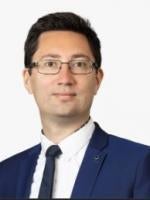NEWS
RUSSIA RESPONDS TO WESTERN SANCTIONS WITH PATENT RETALIATION
On March 6, 2022, the Russian government retaliated against the West’s imposition of sanctions by issuing a decree permitting patented innovations to be used without authorization or payment of consideration if the patent holder is from a “non-allied” country that ordered sanctions.
There are 48 such countries: the 27 European Union member states, Albania, Andorra, Australia, Canada, Iceland, Japan, Lichtenstein, Micronesia, Monaco, Montenegro, New Zealand, North Macedonia, Norway, San Marino, Singapore, and South Korea, Switzerland, Taiwan (China), Ukraine, the United Kingdom, and the United States.
The decree is based on Article 1360 of the Russian Civil Code, which provides that the government may authorize the use of inventions, useful models, and industrial drawings without the owner’s consent in cases of extreme necessity related to national security or protecting the life and health of Russian citizens, provided the owner is informed of and compensated for such use. Until now, compensation had been 0.5 percent of the revenues generated, but this month’s decree eliminates all compensation, thereby imposing free licensing.
The decree affects the following types of patent holders:
-
nationals of the listed countries;
-
legal entities registered to do business in those countries;
-
individuals and legal entities that have their principal place of business or their main source of income in those countries.
It is not yet known, however, which patents will be deemed related to national security or the protection of the life and health of Russian citizens.
PATENTS
SUPPLEMENTARY PROTECTION CERTIFICATE (SPC) - SUBSTANCE IDENTIFIED AS AN EXCIPIENT
CA Paris, January 18, 2022, Société Halozyme Inc. v. INPI (docket no. 20/17731)
The Paris Court of Appeal upheld a French Intellectual Property Institute (INPI) decision via which INPI denied a request for a supplementary protection certificate because the claimed combination of substances cannot be deemed to produce, within the meaning of the European regulation, one of the substances that was clearly identified as an excipient rather than an active ingredient.
Royalty Halozyme Inc. applied to INPI for a supplementary protection certificate (SPS) concerning the “Rituximab and recombinant human hyaluronidase” combination. In its application, it cited (i) a European patent entitled Glycoprotéine d’hyaluronidase soluble (sHASEGP), son procédé de préparation, utilisations et compositions pharmaceutiques le comportant [Soluble hyaluronidase glycoprotein (sHASEGP), process for preparing the same, uses and pharmaceutical compositions comprising thereof] as the underlying patent, and (ii) a marketing authorization for a medicine for human use that contains RItuximab.
According to Article 3 of Regulation (EU) 469/2009, which applies to this case, an SPC may be issued only for a product that is “the active ingredient or combination of active ingredients of a medicinal product” (Article 1(b)) and is “protected by a basic patent in force,” has obtained only its first “valid authorization to place the product on the market as a medicinal product,” and “has not already been the subject of a certificate.”
According to CJEU case law, an excipient, defined by Directive 2011/62/EU as “any constituent of a medicinal product other than the active substance and the packaging material,” is not an active ingredient as defined by Regulation (EU) 469/2009.
In this case, recombinant human hyaluronidase was expressly cited as an excipient in the summary of product characteristics attached to the marketing authorization, in an evaluation of the marketing authorization procedure, and on the medicine’s outer packaging. As per Article 4 of Regulation (EU) 469/2009, the protection granted by an SPC extends only to the product covered by the marketing authorization for the corresponding medicine, namely, the medicine’s active ingredient or combination of active ingredients.
The Court of Appeal found that the scientific documents submitted by Halozyme did not show that recombinant human hyaluronidase had a specific therapeutic effect and should be considered an active ingredient as defined by the Regulation.
It also found that even though “the excipient recombinant human hyaluronidase augments the therapeutic effects of the active ingredient by facilitating its absorption and dispersion through subcutaneous connective tissue,” the combination of substances covered by the SPC application cannot be characterized as a “combination of active ingredients.”
The Court therefore held that since the “Rituximab and recombinant human hyaluronidase” combination is not a product as defined by Article 1(b) of Regulation (EU) 469/2009, Halozyme could not apply for an SPC for that combination.
ADDITIONAL COMPENSATION - DATE THE STATUTE OF LIMITATIONS STARTS TO RUN - PRACTICAL APPROACH
CA Paris, April 1, 2022, Liliane G. v. S.A.S. Institut de Recherche Pierre Fabre (docket no. 21/09523)
The Paris Court of Appeal overruled the finding in a trial preparation judge's order that some of the requests for payment of additional compensation for inventions developed by a former company employee were not time barred, holding that the judge should have taken into consideration the positions she held, tasks she performed, and payments she received in consideration for her inventions.
Ms. G. was hired in 1994 as a pharmacology researcher by the Institut de Recherche Pierre Fabre and dismissed in 2018. In 2005 she had become Director of the Oncology Department. As part of her job as a researcher, she invented or co-invented numerous inventions, including inventions for which patents were:
-
filed between 1999 and 2007 but not exploited; and
-
filed between 2003 and 2012 concerning monoclonal antibodies (Project F50035), for which she received €500, which she deemed inadequate.
According to Article L.611-7 of the French Intellectual Property Code (in the version applicable to this case), inventors must receive additional compensation for inventions they develop as part of their jobs as inventors or the research assigned to them. Before 2013, the limitations period applicable to the additional compensation of salaried inventors was the five-year period provided for under French general law, which runs from the day the right holder knew or should have known the facts enabling her to exercise that right (French Civil Code Article 2224). Since 2013 however, though it begins to run at the same time, the applicable limitations period has been the three-year period provided for under the French Labor Code (Article L.3245-1) for employee actions for payment.
With respect to the inventions that had not been exploited, the Court noted that they had been invented between 1999 and 2006 and that the last patent filing was in November 2007. The Court therefore took a practical approach and found that the five-year statute would have expired no later than November 2012. It then found that Ms. G.'s claim that she did not learn of her right to additional compensation until after the January 2016 entry into force of the salaried-inventors’ compensation system was irrelevant because Article L. 611-7 of the French Intellectual Property Code applied and Ms. G. had received payments based on it. The Court also found that as Department Head then Director of the Oncology Department, Ms. G. was in a position to know what became of her inventions and that the trial preparation judge therefore erred in holding that the statute began to run in January 2016 for the patents that had not been exploited.
With respect to the inventions related to Project F50035 (a research and development partnership with Merck), the Court found that Ms. G. received additional compensation in connection with the filing of patents covering those inventions. It also found that she was heavily involved in that project until it was abandoned in December 2014, and was therefore in a position (i) to know that those patents would not be exploited, and (ii) to determine, at least approximately, how much additional compensation she was owed. The Court further found that “an employee’s claim need only be determinable, not determined,” and that Ms. G.’s claim had been determinable since at least December 2014. The Court then held that the three-year statute of limitations began to run in December 2014 and that Ms. G.’s action related to the Project F50035 inventions, which she filed with the French employee-invention board (Conseil nationale des inventions de salariés) in November 2018, was time barred.
TRADEMARKS
REVOCATION PROCEEDINGS - NO GENUINE USE - NO PROPER REASONS FOR NON-USE
General Court of the EU, January 12, 2022, case no. T-160/21, Laboratorios Ern SA v. Ingrid Malpricht and European Union Intellectual Property Office
The General Court of the European Union required proof of genuine use of the trademark for each product targeted by an application for revocation because the targeted products “form sufficiently autonomous categories.” It also held that the mere existence of a regulation is not a proper reason for non-use (paras. 19 and 24).
Ingrid Malpricht filed an application with EUIPO for revocation of the verbal European Union trademark APIRETAL held by Laboratorios Ern SA for all of the designated Class-5 products except pharmaceutical preparations, namely veterinary preparations, dietetic substances adapted for medical use, food for babies, mouthwashes for medical purposes, and disinfectants for medical purposes.
The Cancellation Division granted the application for revocation and the Fourth Board of Appeal upheld that decision. After noting that the evidence of use concerned only a pharmaceutical preparation for human use (a pediatric antipyretic and analgesic), the General Court also denied Laboratorios Ern’s appeal.
With regard to the concept of genuine use, the Court found that some of the products targeted by the revocation application do not belong in the pharmaceutical preparations category. And while the others have attributes similar to pharmaceutical products, they form sufficiently autonomous categories to warrant requiring proof of use for each such product. The Court also said the probability of future use is not evidence of genuine use, and found that evidence of genuine use of a pharmaceutical product alone was not enough to show genuine use of the trademark for all of the products targeted by the revocation application.
With respect to the concept of proper reasons for non-use, the Court stated that the concept must be interpreted strictly and that “obstacles” to using a trademark must satisfy two conditions.
-
They must “have a sufficiently direct relationship with a trademark, making its use impossible or unreasonable;” and
-
must be beyond the trademark holder's control, it being specified that since a trademark holder must comply with the law, doing so does not constitute an obstacle beyond its control.
In this case, Laboratorios Ern SA argued that the Spanish government had refused to allow it to market a Class-5 product other than a pharmaceutical preparation even though there was a marketing authorization for a medicine for human use of the same name. The Court noted that no steps had been taken to market the products targeted by the revocation application, that the alleged obstacle to using the trademark concerned only Spanish regulations, and that it had not been shown that that obstacle prevented marketing the products in other European Union member states. The Court therefore held that there were no proper reasons for non-use.
OPPOSITION PROCEEDINGS — SIMILARITY OF THE GOODS AND SERVICE – LIKELIHOOD OF CONFUSION – NO EVIDENCE OF PEACEFUL COEXISTENCE
General Court of the EU, March 2, 2022, case no. T149/21, UGA Nutraceuticals Srl v. Vitae Health Innovation, SL and EUIPO
The General Court of the European Union held that pharmaceutical products and dietetic substances for medical use are like other Class-5 goods, such as veterinary preparations, food for babies, and preparations for destroying vermin, and confirmed there was a risk of confusion between the signs in question.
UGA Nutraceuticals Srl filed an international registration application with WIPO for the verbal trademark VITADHA, designating the European Union and various Class-5 goods.
Vitae Health Innovation, SL opposed the registration of that trademark because its earlier Spanish verbal trademark, “VITANADH,” also designates Class-5 goods, namely “pharmaceutical preparations” and “dietetic substances for medical use.”
The Court first stated that registration of a trademark could be denied if there was a likelihood of confusion for a non-negligible portion of the relevant public. The EUIPO Board of Appeal therefore did not err when it analyzed only the likelihood of confusion among the general public, without referring to professionals.
The Court then held that the goods at issue are identical or similar, finding that:
-
“pharmaceutical preparations” include “veterinary preparations.” Such goods are identical or highly similar, as they are of the same nature (healthcare products), have the same purpose (the treatment of health problems), are aimed in part at the same consumers (healthcare professionals and the general public), are manufactured by the same economic operators (pharmaceutical companies), and are distributed through some of the same channels (pharmacies and supermarkets). The claim that “pharmaceutical preparations” refers solely to goods “intended for the treatment of human beings” is not supported by the Nice Agreement (on the classification of goods) or case law;
-
“dietetic substances for medical use” include “dietetic food and substances adapted for veterinary use,” “dietary supplements for animals,” “protein supplements for animals,” and “preparations of trace elements for animal use,” which are also similar to “pharmaceutical preparations;”
-
“preparations for destroying vermin” are somewhat similar to “pharmaceutical preparations” because some preparations for destroying vermin may be used to prevent human or animal health risks, and may also be used in conjunction with pharmaceutical preparations used to treat ailments caused by the presence of or contact with such animal species. In addition, some insecticides may be sold in pharmacies;
-
“food for babies” and “powdered milk for babies” are also somewhat similar to “pharmaceutical preparations” (complementary in connection with treating nutritional deficiencies in babies) and to “dietetic substances for medical use” (special foodstuffs that have the same dietetic purpose).
Lastly, the Court confirmed the likelihood of confusion and denied UGA Nutraceuticals’ appeal even though the EUIPO Board of Appeal erred by comparing the signs without breaking down their constituent elements (the descriptive “vita” component, which will be understood by Spanish consumers, and the “nadh” and “dha” components). Contrary to the appellant’s claim, the “vita” component is not negligible and must be taken into account when assessing the visual, phonetic, and conceptual similarities. In addition, no proof of the peaceful coexistence of the trademarks was submitted.
TRADEMARK VALIDITY - BAD FAITH FILING - REPEAT APPLICATION
EUIPO, Fourth Board of Appeal, March 28, 2022, case no. R 1766/2021-4, X v. L’Oréal The EUIPO Board of Appeal upheld the Cancellation Division's decision and denied X’s petition to void L’Oréal’s trademark application, which X claimed had been filed in bad faith.
X filed a claim seeking to invalidate L’Oréal’s semi-figurative European Union trademark NAKED No. 15 874 928, which covers Class-3 “perfumes, toilet waters, colognes, perfumed oils for skincare, and essential oils,” claiming that L’Oréal had filed a repeat application solely to avoid the genuine use obligation, at least for the designated goods, and to artificially extend the grace period so it would not lose its trademark for lack of use.
Like the Cancellation Division, the Board of Appeal held that the contested trademark application was not a bad faith repeat application.
After noting that there is no legal definition of bad faith, the Board of Appeal (i) underscored that it must take into account all the relevant facts in existence at the time of the filing to determine whether there was bad faith, (ii) specified that bad faith involves conduct that deviates from recognized norms of ethical or honest behavior, and (iii) stated that good faith is presumed until proof of the contrary. The Board of Appeal also stated that repeat applications are not prohibited per se, but may be relevant to establishing bad faith.
In denying X’s claim, the Board of Appeal found that changing a logo over time is standard commercial practice and that filing a trademark application for products for which the holder already has a certain number of trademarks is not an act of bad faith, but lawful conduct that is part of such standard practice. In the case in question, the Board of Appeal noted in particular that:
L’Oréal filed the contested trademark application in 2016, more than two years before X filed an action for revocation of L’Oréal’s earlier verbal European Union trademark NAKED No. 5 773 511 (registered in 2007). It could not have known at that time what the decision in a future action for revocation would be;
-
the contested semi-figurative NAKED trademark is not identical to L’Oréal’s earlier trademarks (verbal NAKED trademark or trademarks including the word “NAKED” and an additional element (GO, URBAN DECAY, SKINS, BASICS));
-
the contested trademark filing was part of a filing of a family of NAKED trademarks;
-
the fact that it based its defense on an earlier trademark subject to a use obligation rather than on the contested trademark is not an obvious sign of bad faith; L’Oréal was free to choose its defense strategy;
-
the earlier verbal European Union trademark NAKED No. 5 773 511 was acquired from a third party, such that the name was not chosen by L’Oréal, which deemed it necessary to file a new application with a shorter name.
The Board of Appeal held that the filing of the contested trademark application did not seem devoid of commercial logic, finding, on the contrary, that there was “continuity, or a ‘commercial path’ that united [L’Oréal’s] trademarks.”
Katya Ascher also contributed to this article.









 />i
/>i
